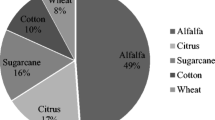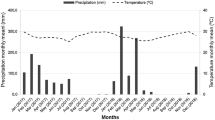Abstract
Seasonal changes in abundances of major soil micro-arthropods were assessed at aPinus pumila scrub in an alpine range of central Japan during a period with no snow coverage. The total abundance showed a peak in late August, reaching no less than 140 000 m−2, which was comparable to that in an evergreen coniferous plantation in the cool-temperate zone. Collembola was the most dominant group of soil micro-arthropods, comprising about 50% of the total, followed by oribatid mites (Acari [O]) occupying 20%. Annual mean air temperature was no more than 2.1 °C and the daily fluctuation in temperature was less in soil layers. The thickness of the A0 layer reached 9–10 cm and soil organic matter accumulation was estimated to be 45–58 ton dry weight ha−1. The large amount of litterfall and organic matter accumulation in the soil, comparable to those of sub-alpine evergreen coniferous forests, and a lower decomposition rate due to severe environmental conditions, suggest the relative importance of litter processing by soil micro-arthropods such as Collembola and Acari, especially in alpine regions.
Similar content being viewed by others
References
Aoki J. (1973)Soil Zoology. Hokuryukan, Tokyo (in Japanese).
Aoki J. (1991)Pictorial Keys to Soil Animals of Japan. Tokai University Press, Tokyo (in Japanese).
Anderson J. M. (1975) Succession, diversity and trophic relationship of some soil animals in decomposing leaf litter.Journal of Animal Ecology 44: 475–495.
Block W. &Zettel J. (1980) Cold-hardiness of some alpine Collembola.Ecological Entomology 5: 1–9.
Cannon R. J. C. &Block W. (1988) Cold tolerance of microroarthropods.Biological Review 63: 23–77.
Crossley D. A. Jr (1977) The roles of terrestrial saprophagous arthropods in forest soils: current status of concepts. In:The Role of Arthropods in Forest Ecosystems (ed. I. W. J. Mattson) pp. 49–56. Springer Verlag, New York.
Dindal D. L. (1990)Soil Biology Guide. Wiley-Interscience, New York.
Hijii N. (1987) Seasonal changes in abundance and spatial distribution of the soil arthropods in a Japanese cedar (Cryptomeria japonica D. Don) plantation, with special reference to Collembola and Acarina.Ecological Research 2: 159–173.
Huhta V., Hyvönen R., Kaasalainen P. et al. (1986) Soil fauna of Finnish coniferous forests.Annales Zoologici Fennici 23: 345–360.
Imadaté G. &Kira T. (1964) Notes on the soil microarthropod collection made by the Thai-Japanese Biological Expedition 1961–62.Nature and Life in Southeast Asia 3: 81–111.
Kajimoto T. (1989) Aboveground biomass and litterfall ofPinus pumila scrubs growing on the Kiso mountain range in central Japan.Ecological Research 4: 55–69.
Kajimoto T. (1990) Photosynthesis and respiration ofPinus pumila needles in relation to needle age and season.Ecological Research 5: 333–340.
Kajimoto T. (1992) Dynamics and dry matter production of belowground woody organs ofPinus pumila trees growing on the Kiso mountain range in central Japan.Ecological Research 7: 333–339.
Kaneko N. (1985) A comparison of oribatid mite communities in two different soil types in a cool temperate forest in Japan.Pedobiologia 28: 255–264.
Kawahara T. (1977) Dynamics of soil organic matter and carbon cycling. In:JIBP Synthesis, Vol. 16. (eds T. Kira & T. Shidei) pp. 132–140. University of Tokyo Press, Tokyo.
Kikuzawa K., Watanabe H., Saichuae P. &Shidei T. (1965) On the biomass of invertebrates in forest floor.Bulletin of the Kyoto University Forests 37: 25–39 (in Japanese with English summary).
Kira T. &Shidei T. (1967) Primary production and turnover of organic matter in different forest ecosystems of the western Pacific.Japanese Journal of Ecology 17: 70–87.
Kitazawa Y. (1977) Ecosystem analysis of the subalpine coniferous forest of the Shigayama IBP area, central Japan,JIBP Synthesis, Vol. 15, University of Tokyo Press, Tokyo.
Niijima K. (1966) Diversity and frequency of Collembola found in three different vegetations of the alpine region of Mt Tateyama, central Japan.Kontyû 34: 339–346 (in Japanese).
Petersen H. &Luxton M. (1982) A comparative analysis of soil fauna populations and their role in decomposition processes.Oikos 39: 288–388.
Saito H. (1977) Litterfall. In:JIBP Synthesis, vol. 16 (eds T. Kira & T. Shidei) pp. 65–75. University of Tokyo Press, Tokyo.
Sasa M. (1975)Mites, 3rd edn. University of Tokyo Press, Tokyo (in Japanese).
Schatz H. &Sømme L. (1981) Cold-hardiness of some oribatid mites from the Alps.Cryo-letters 2: 207–216.
Schaefer M. &Schauermann J. (1990) The soil fauna of beech forests: Comparison between a mull and a moder soil.Pedobiologia 34: 299–314.
Schenker R. (1983) Effects of temperature acclimation on cold-hardiness of alpine micro-arthropods.Revue d'Écologie et de Biologie du Sol 20: 37–47.
Sømme L. (1979) Overwintering ecology of alpine Collembola and oribatid mites from the Australian Alps.Ecological Entomology 4: 175–180.
Swift M. J., Heal O. H. &Anderson J. M. (1979)Decomposition in Terrestrial Ecosystems. Blackwell Scientific Publications, Oxford.
Takeda H. (1983) Feeding attributes of four species of Collembola in a pine forest soil.Pedobiologia 25: 373–381.
Takeda H. (1987) Dynamics and maintenance of collembolan community structure in a forest soil system.Researches on Population Ecology 29: 291–346.
Takeda H. (1988) A 5 year study of pine needle litter decomposition in relation to mass loss and faunal abundances.Pedobiologia 32: 221–226.
Tamura H. (1976) Population studies onFolsomia octoculata (Collembola: Isotomidae) in a subalpine coniferous forest.Revue d'Écologie et de Biologie du Sol 13: 69–91.
Tamura H., Nakamura Y., Yamauchi K. &Fujikawa T. (1969) An ecological survey of soil fauna in Hidaka-Monbetsu, southern Hokkaido.Journal of Faculty of Science, Hokkaido University, Series VI, Zoology 17: 17–57.
Tsutsumi T. (1989) Forest ecology. Asakura, Tokyo (in Japanese).
Usher M. B., Davis P. R., Harris J. R. W. &Longstaff B. C. (1979) A profusion of species? Approaches towards understanding the dynamics of the populations of the microarthropods in decomposer communities. In:Population Dynamics (eds R. M. Anderson, B. D. Turner & L. R. Taylor) pp. 359–384 Blackwell Scientific Publications, Oxford.
Wallwork J. A. (1970)Ecology of Soil Animals. McGraw-Hill, London.
Wallwork J. A. (1983) Oribatids in forest ecosystems.Annual Review of Entomology 28: 109–130.
Watanabe H., Saichuae P. &Shidei T. (1966) On the biomass of soil animals found in various types of forest in Thailand.Southeast Asian Studies 4: 133–139.
Whittaker R. H. (1975)Communities and Ecosystems. Macmillan, New York.
Author information
Authors and Affiliations
About this article
Cite this article
Hijii, N. Abundance patterns of soil micro-arthropods at aPinus pumila scrub in an alpine range of central Japan. Ecol. Res. 9, 175–183 (1994). https://doi.org/10.1007/BF02347493
Received:
Accepted:
Issue Date:
DOI: https://doi.org/10.1007/BF02347493




